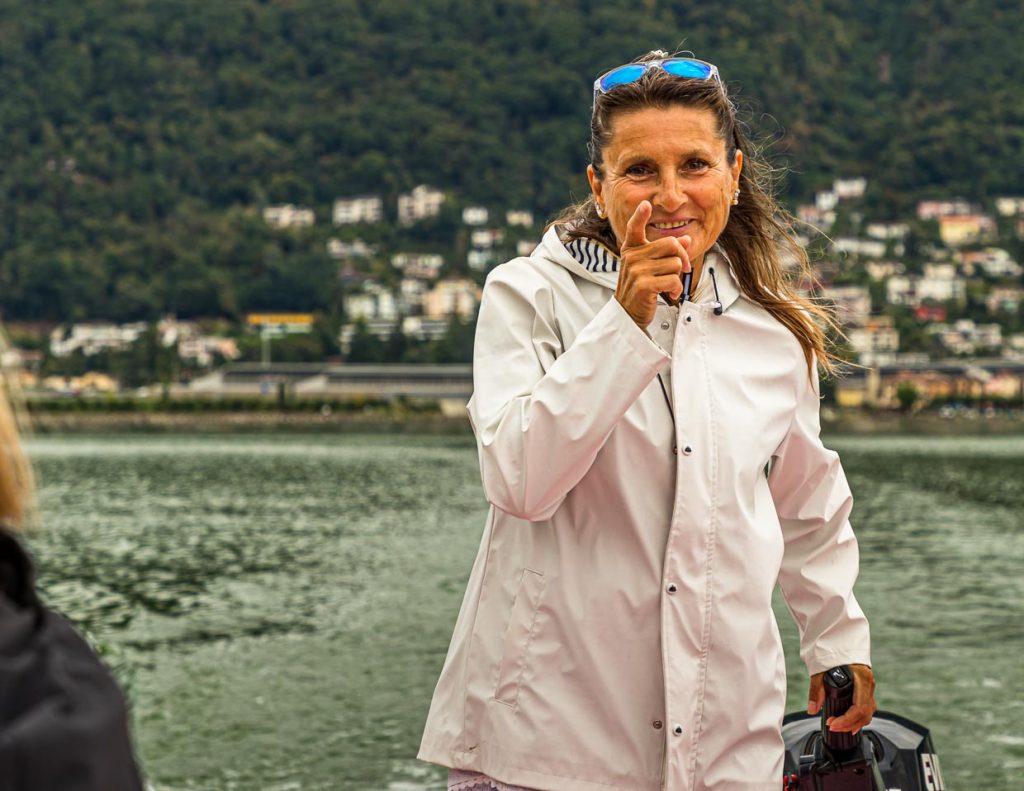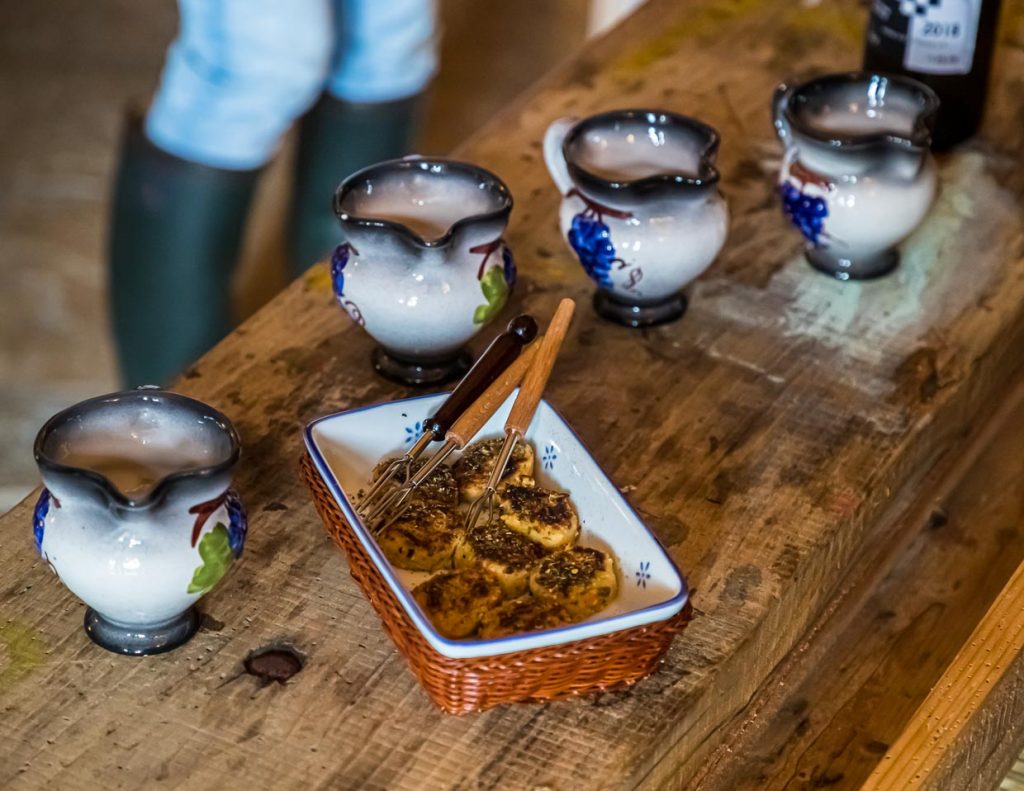A Swiss fishing feast in Melide
Trout, pike, tench, chub and many other fish swim in Lake Lugano. Gabriella Monfredini has spent her whole life on and around Lake Lugano. She grew up in Melide. Even her mother loved to fish for a living and often took her out on the lake. Gabriella Monfredini hosts Swiss Tavolata, where locals serve authentic Swiss cuisine from their own farm, garden or, as in Gabriella’s case, fish from her home lake.

As a teenager, she regularly grabbed her father’s boat. Until her job was taken over by a tape recorder, she worked for the Lake Lugano Navigation Company, announcing stops and sights as a guide. Gabriella was actually the last live announcer on board before the soundtrack replaced her. In 2015, she fulfilled a dream and transformed the old cantine on the outskirts of Melide into a culinary meeting place. Where the villagers used to store cheese, sausage and fish, she has since been cooking typical local fish dishes, some of which have been forgotten, for groups of up to 20 people.

Gabriella, who greets us in front of her cantine, didn’t like fish at all as a child. Until she tried a pike prepared by her grandmother in the Venetian style. The magical cooking of numerous grandmothers has inspired so many chefs. A meal at Gabriella’s is a special experience not only culinary but also atmospheric. The old cantine has a domed ceiling, very rare for these historic cellars, and it gives the long table something solemn. In the back of the room, where the cool air of the mountain used to flow out of the rock face at a temperature of between eight and twelve degrees, there is now a wood-burning stove. To prevent her guests from getting cold feet, Gabriella has unceremoniously turned the natural refrigerator into its opposite.

In rubber boots, Gabriella stands in the kitchen and prepares the aperitif. A whole galaxy of pots and pans circles just below the old domed ceiling. As a welcome, there are small fish cakes and, as a refreshment, a typical summer drink. On hot days, a simple country wine is mixed with lemonade. In order for this mixed drink to taste good, I assume it must be very hot outside. But teaching traditions is at the top of Gabriella’s list, so she didn’t want to deprive us of this summer drink either.

The whole fisherman’s meal is dedicated to almost forgotten fish dishes. While Gabriella puts one dish after the other on the big table, she tells about Melide. Practically the whole street is made up of old cantinas, all of them were once natural cellars, some became garages, others got a floor put on top. Gabriella also had a small apartment built on top of the old family cantina. The celebration of the patron saint of Melide was always held outside at the cantinas. After all, the fish has always been here and freshly prepared on the spot.

There is a fish soup with so many herbs from their own garden that it looks all green and tastes very refreshing. With all fish, whether fatty or lean, a bitter salad is served as a typical summer side dish. It is accompanied by a broth cooked from the head and bones of the filleted fish and with fish meat from the Egli. There is tench in carpione with lemon, oil and many herbs. A traditional dish prepared for the feast of the patron saint of Melide. A salmon trout with beans and raisins is also served. There are boiled eggs garnished with sea caviar from the trout. This is accompanied by roasted white polenta. This goes well with the fish and always reminds Gabriella of her grandmother from Venice. Another fish from Lake Lugano comes smoked. It is Tinka, German for tench, garnished with lots of parsley. Typical of the region is also the allis shad, a fatty fish that is bought already salted and air-dried from the fishmonger and then prepared in bogia, in a large pot.
The fish in Lake Lugano
After the sumptuous fisherman’s meal, we go out on the lake. Gabriela tells us that the shad we just ate is only found in Lake Como. Fish stocks have changed over the years. In the 1970s, for example, there were many aborelle, small freshwater fish. Today they have almost disappeared. At Campione there are many carp and where there are reeds, the pike feels quite comfortable. The perch, on the other hand, can be fished only at certain times. There are fishermen who work with nets, others with rod and bait. The small aborelle is fished with a rod.

There are no more professional fishermen on Lake Lugano. People, Gabriella tells us, had almost forgotten about their own lake fish. From the 1950s on, more and more sea fish was delivered to the towns on Lake Lugano. So the own fish from the lake and with it its preparation fell into oblivion. Then, in 1980, the last fishery in Bissone gave up. This fishmonger still moved from village to village with a sales cart. Today the local lake fish is slowly coming back to the restaurants. In a Frito Misto or a dish of the day you will find fish from Lake Lugano.

Gabriella and the pink and red motorboat
Gabriella also loves to row for a living. She used to help fishermen catch fish. Today she owns a boat herself. I’m sure I’m not the first person to ask her about the pink interior of her motorboat. Why pink? She laughs! She bought the boat from a friend and she remembers how she herself warned this friend against buying it. No fisherman on this planet will buy a pink boat from you, should you ever want to get rid of it. The friend held on to her dream in pink. And when years later Gabriella was looking for a boat, the friend made her an unbeatable offer.

From Morcote we drive over to the other shore of the lake. How wonderfully fast it is to reach all the places on the lake by water. The wind blows in your face and the most beautiful shore passages fly by on the right and left. A great means of transportation – no matter what color.

The research trip was partly supported by Switzerland Tourism on site


